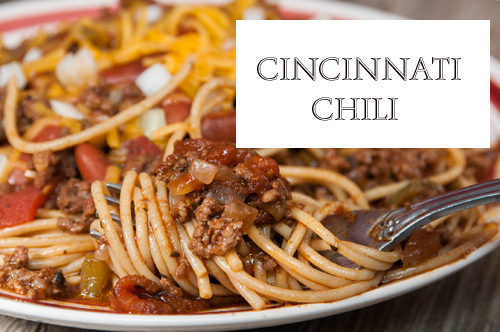Texas-style chili is a bowl of meat with blazing heat. Cincinnati chili tastes more of spices than heat. You ladle Texas chili into a bowl, while Cincinnati chili is served as a topping for spaghetti or hotdogs that the locals call coneys.
In Texas, chiliheads may take a dollop of sour cream and sprinklings of onions and cheese on their chili. But in Cincinnati’s chili parlors, you order a two-, three-, four- or five-way.
Two ways gets you chili served over spaghetti. For a three-way, a shower of finely shredded cheese is added. To get a four-way, you select either onions or kidney beans. Adding oyster crackers makes it a fully loaded five-way.
The chili itself is very moist because the meat is cooked in water when it is made authentically, without being browned and without onions. It looks brown because it is seasoned with cinnamon, allspice and cumin, Worcestershire sauce and chili powder. Cayenne brings some heat. Tomato paste is the only red ingredient.
The unexpected seasonings make sense because the Kiradjieff family, who invented Cincinnati chili in 1922 for their restaurant, the Empress Diner, were Macedonian. My guess is that they were blending ingredients from the meat filling from pastitsio, a ground meat dish from the old country, with what they knew of American chili.
Where does the chocolate come from? It’s an ingredient often used in Cincinnati chili. That came when employees, leaving the Empress to open their own chili parlors around Cincinnati, created their own versions. Some of them added chocolate or cocoa powder and canned tomatoes, too.
I also include onions, plus green pepper, and I brown the meat. But I start cooking the meat without adding any oil. Instead, using gentle heat lets the meat gradually release enough fat to brown it.
With its soupy texture and complex flavor, this chili is delicious served over whole-grain spaghetti. This is my healthy version of a four-way, topped with cheese, raw onion, and beans.
Cincinnati Chili
Makes 4 servings. Per serving: 572 calories, 12 g total fat (3.5 g saturated fat), 78 g carbohydrate, 45 g protein, 9 g dietary fiber, 247 mg sodium
Ingredients:
- 1½ cups chopped onion
- 3/4 cup chopped green bell pepper
- 2 large garlic cloves (finely chopped)
- 1 lb. 94% lean beef
- 2 Tbsp. chili powder
- 1 1/2 tsp. dried basil
- 1 1/2 tsp. dried oregano
- 1 tsp. ground cumin
- 1 can (28 oz. whole tomatoes)
- 1 oz. dark chocolate (70-85% cocoa, coarsely chopped)
- 1 cup reduced-sodium beef broth or water (divided)
- Salt and freshly ground black pepper
- 1/2 lb. whole-wheat spaghetti
- 1 cup no salt added canned kidney beans (rinsed and drained)
- 1/2 cup shredded reduced-fat cheddar cheese
- 1/4 cup finely chopped raw onion
Directions:
In large Dutch oven over medium heat, combine onion, green pepper, garlic and meat. Cook, working with wooden spoon to break up meat, until it loses its red color, about 6 minutes. Mix in chili powder, basil, oregano and cumin, and cook 1 minute longer.
Add tomatoes one at a time, squeezing them through your fist over the pot to break them up. Mix in liquid from tomatoes, chocolate and 1/2 cup broth. Bring to a boil, reduce heat and simmer, 20 minutes. Add remaining broth, season to taste with salt and pepper and cook until chili is dark and fairly moist, 20 to 25 minutes.
Meanwhile, about 15 minutes before chili is done, in large pot of boiling water cook pasta according to package directions until slightly softer than al dente. In heatproof container, microwave kidney beans to heat through. Drain pasta and divide among 4 wide shallow bowls. Top pasta with one fourth of chili, 1/4 cup beans, 2 tablespoons cheese and 1 tablespoon onion.
Something Different is written by Dana Jacobi, author of 12 Best Foods Cookbook and contributor to AICR’s New American Plate Cookbook: Recipes for a Healthy Weight and a Healthy Life.
Our Mission: The American Institute for Cancer Research champions the latest and most authoritative scientific research from around the world on cancer prevention and survival through diet, weight and physical activity, so that we can help people make informed lifestyle choices to reduce their cancer risk.
We have contributed over $105 million for innovative research conducted at universities, hospitals and research centers across the country. Find evidence-based tools and information for lowering cancer risk, including AICR’s Recommendations for Cancer Prevention, at www.aicr.org.
